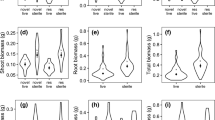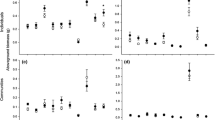Abstract
Plant species generate specific soil communities that feedback on plant growth and competition. These feedbacks have been implicated in plant community composition and dispersion. We used Lactuca sativa and its wild progenitor Lactuca serriola to test the hypotheses that separate Lactuca species generate unique soil communities and that these soil communities differentially influence host, and neighboring, plant growth and competition. We grew each Lactuca in competition with the other, in sterile and non-sterile soils. We then examined the growth of each Lactuca species in sterile, non-sterile, and preconditioned soil. Finally, we used TRFLP techniques to explore whether the two Lactuca species generate significantly different bacterial communities in their rhizosphere soils. L. sativa proved to be the stronger competitor of the two species. However, sterilization increased the competitive effect of L. serriola background competitors. The growth experiment showed a significant effect on plant species, soil treatment, and the interaction of the two. Preconditioning soil caused reduced growth in both Lactuca species. Only L. serriola showed significantly increased growth in sterile soils. Our TRFLP analysis showed that the L. sativa soil community was significantly less diverse and that soil preconditioning had the largest impact on the community composition. These results show that Lactuca serriola’s rhizosphere communities generate a stronger negative feedback for plant growth than do the communities associated with L. sativa. Our study suggests that selection for plants that are able to grow in dense monoculture may have released Lactuca from species-specific negative soil feedbacks. This has important implications for both agriculture and the evolution of invasive plant species.





Similar content being viewed by others
References
Abbot KC, Karst J, Biederman LA, Borrett SR, Hastings A, Walsh V, Bever JD (2015) Spatial heterogeneity in soil microbes alters outcomes of plant competition. PLoS ONE. doi:10.1371/journal.pone.0125788
Aguilera AG (2011) The influence of soil community density on plant-soil feedbacks: an important unknown in plant invasion. Ecol Model 222(18):3413–3420
Aguilera AG, Colon-Carmona A, Kesseli R, Dukes JS (2011) No accession-specific effect of rhizosphere communities on the growth and competition of arabidopsis thaliana accessions. PLoS ONE 6(11):1–8
Berg G, Smalla K (2009) Plant species and soil type cooperatively shape the structure and function of microbial communities in the rhizosphere. Microb Ecol 68:1–13
Bever JD (2003) Soil community feedback and the coexistence of competitors: conceptual frameworks and empirical tests. New Phytol 157(3):465–473
Bever JD, Morton JB, Antonovics J, Schultz PA (1996) Host-dependent sporulation and species diversity of arbuscular mycorrhizal fungi in a mown grassland. J Ecol 84(1):71–82
Bever JD, Westover KM, Antonovics J (1997) Incorporating the soil community into plant population dynamics: the utility of the feedback approach. J Ecol 85:561–573
Bonanomi G, Giannino F, Mazzoleni S (2005) Negative plant-soil feedback and species coexistence. Oikos 111:311–321
Bremer C, Braker G, Matthies D, Reuter A, Engles C, Conrad R (2007) Impact of plant functional group, plant species, and sampling time on the competition of nirK-type denitrifier communities in soil. Appl Environ Microbiol 68:3067–3075
Briones AM, Okabe S, Umemiya Y, Ramsing N, Reichardt W, Okuyama H (2002) Influence of different cultivars on populations of ammonia-oxidizing bacteria in the root environment of rice. Appl Environ Microbiol 74:738–744
Bukowski AR, Peterman JS (2014) Intraspecific plant-soil feedback and intraspecific overyielding in Arabidopsis thaliana. Ecol Evol 4(12):2533–2545
Cardinale M, Grube M, Erlacher A et al (2015) Bacterial networks and co-occurrence relationships in the lettuce root microbiota. Environmental Microbiology 17(1):239–252
Casper BB, Castelli JP (2007) Evaluating plant-soil feedbacks together with competition in a serpentine grassland. Ecol Lett 10:394–400
Culman SW, Bukowski R, Gauch HG, Cadillo-Quiroz H, Buckley DH (2009) T-REX: software for the processing and analysis of T-RFLP data. BMC Bioinform 10:171
de Vries IM (1990) Crossing experiments of lettuce cultivars and species (lactuca sect, lactuca, compositae). Plant Syst Evol 171(1–4):233–248
Ehrenfeld JG (2003) Effects of exotic plant invasions on soil nutrient cycling processes. Ecosystems 6(6):503–523
Fox J, Weisberg S, Bates D (2010) car: Companion to Applied Regression. R package version 2.0-2
Goldberg DE, Barton AM (1992) Patterns and consequences of interspecific competition in natural communities: a review of field experiments with plants. Am Nat 139(4):771–801
Grayston SJ, Prescott CE (2005) Microbial communities in forest floors under four tree species in coastal British Columbia. Soil Biol Biochem 37(6):1157–1167
Haney CH, Samuel BS, Bush J, Ausubel F (2015) Associations with rhizosphere bacteria can confer an adaptive advantage to plants. Nat Plants. doi:10.1038/nplants.2015.51
Heinze J, Werner T, Weber E, Rillig MC, Joshi J (2015) Soil biota effects on local abundances of three grass species along a land-use gradient. Oecologia 179(1):249–259
Hendriks M, Ravenek JM, Smit-Tiekstra AE, van der Paauw JW, de Caluwe H, van der Putten WH, de Kroon H, Mommer L (2015) Spatial heterogeneity of plant-soil feedback affects root interactions and interspecific competition. New Phyt. 207:830–840
Hill M, Witsenboer H, Zabeau M, Vos P, Kesseli R, Michelmore R (1996) Amplified fragment length polymorphisms (AFLPs) as a tool for assessing the genetic relationships in Lactuca spp. Theor Appl Genet 93:1202–1210
Jost L (2006) Entropy and diversity. Oikos 113:363–375
Kardol P, Bezemer TM, van der Putten WH (2006) Temporal variation in plant-soil feedback controls succession. Ecol Lett 9:1080–1088
Kardol P, Cornips NJ, van Kempen MML, Bakx-Schotman JMT, van der Putten WH (2007) Microbe-mediated plant-soil feedback causes historical contingency effects in plant community assembly. Ecol Monographs 77(2):147–162
Kesseli R, Michelmore R (1996) The compositae: systematically fascinating but specifically neglected. In: Paterson A (ed) Genome mapping in plants. Landes Press, Georgetown, pp 181–194
Kesseli R, Ochoa O, Michelmore R (1991) Variation at RFLP loci in Lactuca spp. and origin of cultivated lettuce (L. sativa). Genome 34(3):430–436
Klironomos JN (2002) Feedback with soil biota contributes to plant rarity and invasiveness in communities. Nature 417:67–70
Kulmatiski A, Beard KH, Stevens JR, Cobbold SM (2008) Plant-soil feedbacks: a meta-analytical review. Ecol Lett 11(9):980–992
Kulmatiski A, Beard KH, Grenzer J, Forero L, Heavilin J (2016) Using plant-soil feedbacks to predict plant biomass in diverse communities. Ecology 97(8):2064–2073
Lebeda A, Dolezalova I, Kristkova E, Mieslerova B (2001) Biodiversity and ecogeography of wild Lactuca spp. in some European countries. Genet Resour Crop Evol 48:153–164
Levin JM, Adler PB, Yelenick SG (2004) A meta-analysis of biotic resistance to exotic plant invasions. Ecol Lett 7:975–989
Lindqvist K (1960) Cytogenetic studies in the serriola group of Lactuca. Hereditas. 46(1–2):75–151
Mangan SA, Schnitzer SA, Herre EA, Mack KML, Valencia MC, Sanchez EI, Bever JD (2010) Negative plant-soil feedback predicts tree-species relative abundance in a tropical forest. Nature 466:752–755
Maron JL, Smith AL, Ortega YK, Pearson DE, Callaway RM (2016) Negative plant-soil feedbacks increase with plant abundance, and are unchanged by competition. Ecology 97(8):2055–2063
Masclaux F, Hammond RL, Meunier J, Gouhier-Darimont C, Keller L, Reymond P (2010) Competitive ability not kinship affects growth of arabidopsis thaliana accessions. New Phytol 185(1):322–331
McArdle BH, Anderson MJ (2001) Fitting multivariate models to community data: a comment on distance-based redundancy analysis. Ecology 82:290–297
Micallef SA, Shiaris MP, Colon-Carmona A (2009) Influence of arabidopsis thaliana accessions on rhizobacterial communities and natural variation in root exudates. J Exp Bot 60(6):1729–1742
Morris WF, Hufbauer RA, Agrawal AA, Bever JD, Borowicz VA, Gilber GS et al (2007) Direct and interactive effects of enemies and mutualists on plant performance: a meta-analysis. Ecology 88:1021–1029
Nocker A, Burr M, Camper AK (2007) Genotypic microbial community profiling: a critical technical review. Microb Ecol 54:276–289
Oksanen J, Kindt R, Legendre P, O’Hara B, Stevens MHH, Oksanen MJ, Suggests M (2007) The vegan package. Community ecology package 10
Panke-Buisse K, Poole AC, Goodrich JK, Ley RE, Kao-Kniffin J (2015) Selection on soil microbes reveals reproducible impacts on plant function. ISME J 9:980–989
Parepa M, Fischer M, Bossdorf O (2013) Environmental variability promotes plant invasion. Commun. doi:10.1038/ncomms2632
Pendergast TH IV, Burke DJ, Carson WP (2013) Belowground biotic community drives aboveground dynamics: a test of the soil community feedback model. New Phytol 197:1300–1310
Polz M, Cavanaugh C (1998) Bias in product-to-template ratios in multitemplate PCR. Appl Environ Microbiol 64:3724–3730
Priha O, Grayston SJ, Hiukka R, Pennanen T, Smolander A (2001) Microbial community structure and characteristics of the organic matter in soils under pinus sylvestris, picea abies and betula pendula at two forest sites. Biol Fertil Soils 33(1):17–24
Raaijamkers JM, Paulitz CT, Steinberg C, Alabouvette C, Moennne-Loccoz T (2009) The rhizosphere: a playground for soilborne pathogens and beneficial microorganisms. Plant Soil. doi:10.1007/s11104-008-9568-6
Ralser M, Querfurth R, Warnatz H-J, Lehrach H, Yaspo M-L, Krobitsch S (2006) An efficient and economic enhancer mix for PCR. Biochem Biophys Res Commun 347:747–751
Reinhart KO (2012) The organization of plant communities: negative plant-soil feedbacks and semiarid grasslands. Ecology 93(11):2377–2385
Reinhart KO, Callaway RM (2006) Soil biota and invasive plants. New Phytol 170(3):445–457
Reinhart KO, Packer A, Van der Putten WH, Clay K (2003) Plant-soil biota interactions and spatial distribution of black cherry in its native and invasive ranges. Ecol Lett 6:1046–1050
Rustad LE, Campbell JL, Marion GM, Norby RJ, Mitchell MJ, Hartley AE (2001) A meta-analysis of the response of soil respiration, net nitrogen mineralization, and aboveground plant growth to experimental ecosystem warming. Oecologia 126:543–562
Ryder EJ, Whitaker TW, Lettuce NE, Simmonds (eds) (1976) Evolution of crop plants. Longman Group Ltd., London
Schlaeppi K, Dombrowski N, Oter RG, van Themaat EVL, Schulze-Lefert P (2014) Quantitative divergence of the bacterial root microbiota in Arabidopsis thaliana relatives. Proc Natl Acad Sci 111:585–592
Schweitzer JA, Bailey JK, Fischer DG, LeRoy CJ, Lonsdorf EV, Whitham TG, Hart SC (2008) Plant-soil- microorganism interactions: heritable relationship between plant genotype and associated soil microorganisms. Ecology 89(3):773–781
Stoffel K, van Leeuwen H, Kozik A, Caldwell D, Ashrafi H, Cui X, Tan X, Hill T, Reyes-Chin-Wo S, Truco M-J (2012) Development and application of a 6.5 million feature Affymetrix Genechip® for massively parallel discovery of single position polymorphisms in lettuce (Lactuca spp.). BMC Genom 13:1
Templer P, Findlay S, Lovett G (2003) Soil microbial biomass and nitrogen transformations among five tree species of the Catskill Mountains, New York. USA. Soil Biol Biochem. 35(4):607–613
terHorst CP, Zee PC (2016) Eco-evolutionary dynamics in plant-soil feedbacks. Funct Ecol 30:1062–1072
Trevors JT (1996) Sterilization and inhibition of microbial activity in soil. J Microbiol Methods 26:53–59
Truco MJ, Antonise R, Lavelle D, Ochoa O, Kozik A, Witsenboer H, Fort S, Jeuken M, Kesseli R, Lindhout P, Michelmore R, Peleman J (2007) A high-density integrated genetic linkage map of lettuce (Lactuca spp.). Theor Appl Genet 115:735–746
Uwimana B, Smulders MJ, Hooftman DA, Hartman Y, van Tienderen PH, Jansen J, McHale LK, Michelmore RW, van de Wiel CC, Visser RG (2012) Hybridization between crops and wild relatives: the contribution of cultivated lettuce to the vigour of crop-wild hybrids under drought, salinity and nutrient deficiency conditions. Theor Appl Genet 125(6):1097–1111
Van Nuland ME, Wooliver RC, Pfennigwerth AA, Read QD, Ware IM, Mueller L, Fordyce JA, Schweitzer JA, Bailey JK (2016) Plant-soil feedback: connecting ecosystem ecology and evolution. Funct Ecol 30:1032–1042
Wagner MR, Lundberg DS, Coleman-Derr D, Tringe SG, Dangl JL, Mitchell-Olds T (2014) Natural soil microbes alter flowering phenology and the intensity of selection on flowering time in a wild Arabidopsis relative. Ecol Lett 17:717–726
Westover KM, Bever JD (2001) Mechanisms of plant species coexistence: roles of rhizosphere bacteria and root fungal pathogens. Ecology 82(12):3285–3294
Wickham H (2011) The split-apply-combine strategy for data analysis. J Stat Softw 40:1–29
Wilson SD, Tilman D (1991) Components of plant competition along an experimental gradient of nitrogen availability. Ecology 72:1050–1065
Xiong S, Nilsson CJ (1999) The effects of plant litter on vegetation: a meta-analysis. Ecology 87:984–994
Acknowledgements
This work was funded in part by the National Science Foundation grants IOS 0847691 and DBI 0820451, and The University of Massachusetts, Boston. We also thank anonymous reviewers for their helpful comments and suggestions.
Author information
Authors and Affiliations
Corresponding author
Additional information
Communicated by Lori Biederman.
Appendix
Appendix
See Fig. 6.
Rights and permissions
About this article
Cite this article
Aguilera, A.G., Morey, S., Gammon, M. et al. Effect of plant–soil feedbacks on the growth and competition of Lactuca species. Plant Ecol 218, 359–372 (2017). https://doi.org/10.1007/s11258-016-0697-3
Received:
Accepted:
Published:
Issue Date:
DOI: https://doi.org/10.1007/s11258-016-0697-3





